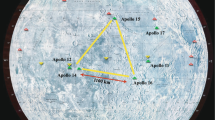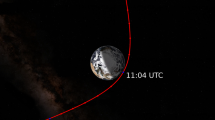Abstract
The Gravity Recovery and Interior Laboratory (GRAIL) is a spacecraft-to-spacecraft tracking mission that was developed to map the structure of the lunar interior by producing a detailed map of the gravity field. The resulting model of the interior will be used to address outstanding questions regarding the Moon’s thermal evolution, and will be applicable more generally to the evolution of all terrestrial planets. Each GRAIL orbiter contains a Lunar Gravity Ranging System instrument that conducts dual-one-way ranging measurements to measure precisely the relative motion between them, which in turn are used to develop the lunar gravity field map. Each orbiter also carries an Education/Public Outreach payload, Moon Knowledge Acquired by Middle-School Students (MoonKAM), in which middle school students target images of the Moon for subsequent classroom analysis. Subsequent to a successful launch on September 10, 2011, the twin GRAIL orbiters embarked on independent trajectories on a 3.5-month-long cruise to the Moon via the EL-1 Lagrange point. The spacecraft were inserted into polar orbits on December 31, 2011 and January 1, 2012. After a succession of 19 maneuvers the two orbiters settled into precision formation to begin science operations in March 1, 2012 with an average altitude of 55 km. The Primary Mission, which consisted of three 27.3-day mapping cycles, was successfully completed in June 2012. The extended mission will permit a second three-month mapping phase at an average altitude of 23 km. This paper provides an overview of the mission: science objectives and measurements, spacecraft and instruments, mission development and design, and data flow and data products.













Similar content being viewed by others
References
E.L. Akim, Determination of the gravitational field of the Moon from the motion of the artificial lunar satellite “Lunar-10”. Dokl. Akad. Nauk SSSR 170 (1966)
M.P. Ananda, Lunar gravity: a mass point model. J. Geophys. Res. 82, 3040–3064 (1977)
S.W. Asmar et al., The scientific measurement system of the Gravity Recovery and Interior Laboratory (GRAIL) mission. Space Sci. Rev. (2012, this issue)
M.J. Chung, S.J. Hatch, J.A. Kangas, S.M. Long, R.B. Roncoli, T.H. Sweetser, Trans-lunar cruise trajectory design of GRAIL mission, in AIAA Astrodynamics Conf., Toronto, CA (2010)
C. Dunn et al., The instrument on NASA’s GRACE mission: augmentation of GPS to achieve unprecedented gravity field measurements, in Proc. 15th Int. Tech. Meeting of Satellite Division of Institute of Navigation, Portland, OR, 2002, pp. 724–730
L.T. Elkins-Tanton, Linked magma ocean solidification and atmospheric growth for Earth and Mars. Earth Planet. Sci. Lett. 271, 181–191 (2008)
GAO, US Government Accountability Office Report to Congressional Committees, NASA—Assessments of Selected Large-Scale Projects (U.S. Government Accountability Office, Washington, 2012), p. 16
S.J. Hatch, R.B. Roncoli, T.H. Sweetser, GRAIL trajectory design: lunar orbit insertion through science, in AIAA Astrodynamics Conf., Toronto, CA (2010). AIAA 2010-8385, 8 pp.
W.A. Heiskanen, H. Moritz, Physical Geodesy (W.H. Freeman, San Francisco/London, 1967)
T.L. Hoffman, GRAIL: gravity mapping the Moon, in IEEE Aerospace Conference, Big Sky, MT, 978-1-4244-2622-5 (2009)
L.L. Hood, M.T. Zuber, Recent refinements in geophysical constraints on lunar origin and evolution, in Origin of the Earth and Moon, ed. by R.M. Canup, K. Righter (Univ. of Ariz. Press, Tucson, 2000), pp. 397–409
M.D. Johnson, J.E. Graf, R.W. Zurek, H.J. Eisen, B. Jai, The Mars Reconnaissance Orbiter mission, in IEEE Aerospace Conf. (2005)
W.M. Kaula, Theory of Satellite Geodesy (Blaisdell, Waltham, 1966), 124 pp.
W.M. Klipstein et al., The lunar gravity ranging system for the Gravity Recovery and Interior Laboratory (GRAIL) mission. Space Sci. Rev. (2012, this issue)
A.S. Konopliv, S.W. Asmar, E. Carranza, W.L. Sjogren, D.-N. Yuan, Recent gravity models as a result of the Lunar Prospector mission. Icarus 150, 1–18 (2001)
A.S. Konopliv, A. Binder, L. Hood, A. Kucinskas, W.L. Sjogren, J.G. Williams, Gravity field of the Moon from Lunar Prospector. Science 281, 1476–1480 (1998)
F.G. Lemoine, D.E. Smith, M.T. Zuber, G.A. Neumann, D.D. Rowlands, A 70th degree and order lunar gravity model from Clementine and historical data. J. Geophys. Res. 102, 16339–16359 (1997)
E. Mazarico, F.G. Lemoine, S.-C. Han, D.E. Smith, GLGM-3, a degree-150 lunar gravity model from the historical tracking data of NASA Moon orbiters. J. Geophys. Res. 115, E050001 (2010). doi:10.1029/2009JE003472
K. Matsumoto et al., An improved lunar gravity field model from SELENE and historical tracking data: revealing the farside gravity features. J. Geophys. Res. 115 (2010). doi:10.1029/2009JE003499
P.M. Muller, W.L. Sjogren, Mascons: lunar mass concentrations. Science 161, 680–684 (1968)
N. Namiki et al., Farside gravity field of the Moon from four-way Doppler measurements of SELENE (Kaguya). Science 323, 900–905 (2009)
G.A. Paulikas et al., The Scientific Context for Exploration of the Moon: Final Report (National Research Council, Washington, 2007), 120 pp.
R.J. Phillips, J.E. Conel, E.A. Abbot, W.L. Sjogren, J.B. Morton, Mascons: progress toward a unique solution for mass distribution. J. Geophys. Res. 77, 7106–7114 (1972)
R.J. Phillips, W.L. Sjogren, E.A. Abbott, S.H. Zisk, Simulation gravity modeling to spacecraft tracking data: analysis and application. J. Geophys. Res. 83, 5455–5464 (1978)
R.B. Roncoli, K.K. Fujii, Mission design overview for the Gravity Recovery and Interior Laboratory (GRAIL) mission, in AIAA Guidance, Navigation and Control Conference, AIAA 2010-9393, Toronto, Ontario, Canada (2010), 22 pp.
T.H. Sweetser, M.S. Wallace, S.J. Hatch, R.B. Roncoli, Design of an extended mission for GRAIL, in AIAA Astrodynamics Specialist Conference, AIAA-2012-4439, Minneapolis, MN (2012), 18 pp.
B.D. Tapley, S. Bettadpur, J.C. Ries, P.F. Thompson, M.M. Watkins, GRACE measurements of mass variability in the Earth system. Science 305 (2004). doi:10.1126/science.1099192
R.L. Taylor, M.T. Zuber, D.H. Lehman, T.L. Hoffman, Managing GRAIL: getting to launch on cost, on schedule and on spec, in IEEE Aerospace Conference, Big Sky, MT (2012)
J.B. Thomas, An analysis of gravity-field estimation based on intersatellite dual-1-way biased ranging, Jet Propulsion Laboratory (1999), 196 pp.
M.S. Wallace, T.H. Sweetser, R.B. Roncoli, Low lunar orbit design via graphical manipulation of eccentricity vector evolution, in AIAA Astrodynamics Conference, Minneapolis, MN (2012)
L. Wong, G. Buechler, W. Downs, W. Sjogren, P. Muller, P. Gottlieb, A surface layer representation of the lunar gravity field. J. Geophys. Res. 76, 6220–6236 (1971)
J.A. Wood, J.S. Dickey, U.B. Marvin, B.N. Powell, Lunar anorthosites and a geophysical model for the Moon, in Proc. Apollo 11 Lunar Sci. Conf., vol. 1 (1970), pp. 965–988
M.T. Zuber, D.E. Smith, F.G. Lemoine, G.A. Neumann, The shape and internal structure of the Moon from the Clementine mission. Science 266, 1839–1843 (1994)
M.T. Zuber, D.E. Smith, D.H. Lehman, M.M. Watkins, Gravity Recovery and Interior Laboratory mission: facilitating future exploration to the Moon, in Int. Astronaut. Congress, Naples, Italy (2012)
Acknowledgements
The GRAIL mission is supported by NASA’s Discovery Program and is performed under contract to the Massachusetts Institute of Technology. Part of this work was carried out at the Jet Propulsion Laboratory, California Institute of Technology, under a contract with the National Aeronautics and Space Administration.
Author information
Authors and Affiliations
Corresponding author
Appendix
Appendix
Acronyms and Abbreviations | |
|---|---|
CBE | Current Best Estimate |
CCAFS | Cape Canaveral Air Force Station |
C&DH | Command & Data Handling |
CM | Center of Mass |
DSN | Deep Space Network |
ECM | Eccentricity Correction Maneuver |
E/PO | Education and Public Outreach |
GB | Gigabytes |
GDS | Ground Data System |
GPA | Gravity Processing Assembly |
GR-A | GRAIL-A Spacecraft (Ebb) |
GR-B | GRAIL-B Spacecraft (Flow) |
GRACE | Gravity Recovery and Climate Experiment |
GRAIL | Gravity Recovery and Interior Laboratory |
GSFC | Goddard Space Flight Center |
ITAR | International Traffic in Arms Regulations |
JPL | Jet Propulsion Laboratory |
KBR | Ka-Band Ranging |
LGRS | Lunar Gravity Ranging System |
LMSSC | Lockheed Martin Space Systems Company (Denver) |
LOI | Lunar Orbit Insertion |
LOLA | Lunar Orbiter Laser Altimeter |
LOS | Line of Sight |
LRO | Lunar Reconnaissance Orbiter |
mascon | Mass Concentration |
mGal | milliGal (where 1 Gal = 0.01 m s−2) |
MIT | Massachusetts Institute of Technology |
MoonKAM | Moon Knowledge Acquired by Middle school students |
MOC | Mission Operations Center |
MOS | Mission Operations System |
MGSS | Multi-mission Ground System Services |
MMDOM | Multimission Distributed Object Manager |
MPST | Mission Planning and Sequence Team |
MWA | Microwave Assembly |
NAIF | Navigation and Ancillary Information Facility |
NASA | National Aeronautics and Space Administration |
OPR | Orbital Period Reduction |
OTM | Orbit Trim Maneuver |
PDS | Planetary Data System |
PM | Primary Mission |
RSB | Radio Science Beacon |
SCT | Spacecraft Team |
SDS | Science Data System |
SIS | Software Interface Specification |
SRS | Sally Ride Science |
TCM | Trajectory Correction Maneuver |
TDS | Telemetry Delivery System |
TLC | Trans-Lunar Cruise |
TSF | Transition to Science Formation |
TSM | Transition to Science Maneuver |
TTS | Time Transfer System |
USO | Ultra-stable Oscillator |
XM | Extended Mission |
XSS-11 | Experimental Satellite System 11 |
Rights and permissions
About this article
Cite this article
Zuber, M.T., Smith, D.E., Lehman, D.H. et al. Gravity Recovery and Interior Laboratory (GRAIL): Mapping the Lunar Interior from Crust to Core. Space Sci Rev 178, 3–24 (2013). https://doi.org/10.1007/s11214-012-9952-7
Received:
Accepted:
Published:
Issue Date:
DOI: https://doi.org/10.1007/s11214-012-9952-7




